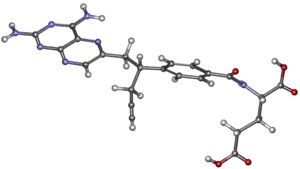Pralatrexate
 | |
 | |
| Names | |
|---|---|
| Trade names | Folotyn |
IUPAC name
| |
| Clinical data | |
| Drug class | Dihydrofolate reductase inhibitor[1] |
| Main uses | Peripheral T-cell lymphoma (PTCL)[1] |
| Side effects | Inflammation of the mouth, low platelets, nausea, tiredness[1] |
| WHO AWaRe | UnlinkedWikibase error: ⧼unlinkedwikibase-error-statements-entity-not-set⧽ |
| Pregnancy category |
|
| Routes of use | Intravenous |
| Typical dose | 30 mg/m2[1] |
| External links | |
| AHFS/Drugs.com | Monograph |
| Legal | |
| License data |
|
| Legal status |
|
| Chemical and physical data | |
| Formula | C23H23N7O5 |
| Molar mass | 477.481 g·mol−1 |
| 3D model (JSmol) | |
SMILES
| |
InChI
| |
Pralatrexate, sold under the brand name Folotyn, is a medication to treat peripheral T-cell lymphoma (PTCL).[1] It is used when other treatments have failed.[1] It is given by injection into a vein.[1]
Common side effects include inflammation of the mouth, low platelets, nausea, and tiredness.[1] Other side effects may include rash, tumor lysis syndrome, liver problems, and bone marrow suppression.[1] Use in pregnancy may harm the baby.[1] It is a dihydrofolate reductase inhibitor.[1]
Pralatrexate was approved for medical use in the United States in 2009.[1] Its approval was refused in Europe in 2012 due to insufficient evidence of benefit.[2] In the United States 60 mg of medication costs about 18,000 USD.[3]
Medical uses
Pralatrexate is used for the treatment of relapsed or refractory peripheral T-cell lymphoma (PTCL).[1]
Dosage
The typical dose is 30 mg/m2 once per week.[1] Half the dose is used in people with significant kidney problems.[1] It is given for 6 weeks with 1 week off.[4]
Mechanism
Pralatrexate is a dihydrofolate reductase inhibitor.[1]
History
Research on this class of drugs began in the 1950s at SRI International, where scientists were focused on developing new chemotherapies and antifolates that would be effective against tumor cells.[5]
In the late 1970s, researchers at Memorial Sloan Kettering Cancer Center discovered that cancerous cells take in natural folate through a protein identified as plasma membrane transporter (now referred to as "reduced folate carrier type 1" or "RFC-1"). Further research showed that when normal cells evolve into cancerous cells they often overproduce RFC-1 to ensure they get enough folate.[6]
A subsequent scientific collaboration was ultimately formed among SRI International, Memorial Sloan Kettering Cancer Center, and the Southern Research Institute with the intention of developing an antifolate with greater therapeutic selectivity – an agent that could be more effectively internalized into tumors (transported into the cells through RFC-1) and would be more toxic to cancer cells than normal cells.[6]
This collaboration, supported by the National Cancer Institute,[7] led to the identification of pralatrexate in the mid-1990s. Pralatrexate was later licensed to Allos Therapeutics in 2002 for further development.[8] Allos Therapeutics, Inc. was acquired by Spectrum Pharmaceuticals, Inc. on September 5, 2012. Allos is a wholly owned subsidiary of Spectrum.[9]
Society and culture
Legal status
Pralatrexate was approved for medical use in the United States in September 2009.[10][11]
Economics
Some oncologists, patient groups, and insurance companies criticized the cost of $30,000 a month or more, which could reach a total of $126,000 during a course of treatment.[12]
See also
References
- 1 2 3 4 5 6 7 8 9 10 11 12 13 14 15 16 "Folotyn- pralatrexate injection". DailyMed. 28 May 2020. Archived from the original on 30 March 2021. Retrieved 21 October 2020.
- ↑ "Folotyn". Archived from the original on 26 November 2020. Retrieved 29 October 2021.
- ↑ "Pralatrexate Prices, Coupons & Savings Tips - GoodRx". GoodRx. Retrieved 29 October 2021.
- ↑ "Pralatrexate Monograph for Professionals". Drugs.com. Archived from the original on 23 September 2020. Retrieved 29 October 2021.
- ↑ "Archived copy". Archived from the original on 2013-01-17. Retrieved 2010-09-20.
{{cite web}}: CS1 maint: archived copy as title (link), Allos Therapeutics Press Release, "Allos Therapeutics' Pralatrexate Demonstrates Anticancer Activity in Multiple Cancer Cell Lines". - 1 2 Archived 2011-06-29 at the Wayback Machine, Memorial Sloan Kettering Cancer Center Press Release, "FDA Approves Lymphoma Drug Developed at Memorial Sloan Kettering".
- ↑ "The NExT Steps in Drug Development at NCI". NCI Cancer Bulletin. 20 October 2009. Archived from the original on 5 October 2014. Retrieved 22 January 2021.
- ↑ "FDA Approves Pralatrexate for Treatment of Peripheral T-Cell Lymphoma" (Press release). SRI International. 2009-09-25. Archived from the original on 2013-07-03. Retrieved 2013-07-10.
- ↑ Avery G (2012-09-07). "Purchase of Allos Therapeutics is completed". Denver Business Journal. Archived from the original on 2013-03-18. Retrieved 2013-07-10.
- ↑ "Drug Approval Package: Folotyn (Pralatrexate) Injection NDA #022468". U.S. Food and Drug Administration (FDA). 23 November 2009. Archived from the original on 4 April 2021. Retrieved 21 October 2020.
- ↑ "FDA Approves First Drug for Treatment of Peripheral T-cell Lymphoma". U.S. Food and Drug Administration (FDA) (Press release). 25 September 2009. Archived from the original on 1 October 2009. Retrieved 21 October 2020.
 This article incorporates text from this source, which is in the public domain.
This article incorporates text from this source, which is in the public domain. - ↑ Pollack A (December 4, 2009). "Questioning a Cancer Drug That Costs $30,000 a Month". New York Times. Archived from the original on 2021-10-20. Retrieved 2009-12-05.
The price of the new drug, called Folotyn, is at least triple that of other drugs that critics have said are too expensive for the benefits they offer to patients.
External links
| External sites: |
|
|---|---|
| Identifiers: |
- "Pralatrexate". NCI Drug Dictionary. National Cancer Institute. Archived from the original on 2020-10-29. Retrieved 2021-01-22.
- "Pralatrexate". National Cancer Institute. Archived from the original on 2021-01-20. Retrieved 2021-01-22.